Walsall Corporation Tramways
History
Walsall Corporation became a tramway owner on the 1st January 1901, when it purchased the tracks of the South Staffordshire Tramways Company that lay within the borough boundary.
The corporation was able to force through the purchase courtesy of the Tramways Act of 1870, which gave local authorities the right to acquire tramway undertakings within their municipality — usually 21 years after the act that enabled the tramway's construction — the main one in this case being the Walsall and District Tramways Order of 1880. The first tramway service within Walsall commenced on the 4th December 1884, and was steam hauled; the gauge was 3ft 6ins, which eventually became the prevalent gauge in Birmingham and the Black Country, and was owned and operated by the South Staffordshire and Birmingham District Steam Tramways Company. The company was restructured in 1889, changing its name to the South Staffordshire Tramways Company.
The company was an early adopter of electric traction, commencing services on the 1st January 1893, it being the second overhead electric tramway to open in the British Isles. These early electric lines ran between Darlaston and Mellish Road (in Walsall), and Wednesbury and Bloxwich; both routes shared a central spine between Pleck in the south, and central Walsall.
The corporation opened preliminary discussions with the SSTCo in 1896, so it was, by this time, clearly giving serious consideration to bringing the tramway into municipal ownership. Events though, took a fairly dramatic turn in mid-1897 with the appearance of the British Electric Traction Company, which had gained control of the SSTCo, and which was developing ambitious plans for a large overhead electric tramway network spanning Birmingham and the Black Country. However, before embarking on what would be an extremely expensive programme of electrification, it was essential that the BETCo reach agreement with all the local authorities through whose territories the various tramways ran, either for them to defer their right to buy, or to purchase the tramways then lease operation to the company. Unfortunately for the latter, the authorities were numerous, and the BETCo's attempts to secure agreements across all of them foundered.
Although Walsall Corporation played a key role in opposing these plans, and was clearly intent on taking control of the tramways within its boundary, in early 1899, it seemed that key players in the council were inclining towards leasing operation of the tramway to a company. In July 1899, the corporation set things in motion by applying to the Board of Trade for approval to purchase the tramways, and at the same time, it gave notice to the BETCo that it would withdraw its consent to electric operation (within the borough) in six months' time, and would, furthermore, require the company to remove all the overhead infrastructure. This was presumably designed to send a clear message to the BETCo that the council was serious, a move it followed up in September 1899, by a decision to apply for powers to take over ownership of the tramway, to build extensions to the existing lines, and to operate services itself if it so chose. These moves certainly had the desired effect on the SSTCo (and, therefore, the BETCo), which agreed — on the 23rd November 1899 — to sell the tramway infrastructure within the municipal boundary to the corporation on the 1st January 1901.
The corporation received its powers on the 6th August 1900 — under the Walsall Corporation Act (1900) — and took over the tramway, as agreed, on the 1st January 1901. The corporation was at this time in no position to operate the tramway itself, nor had it decided to do so, so tramway operation was leased to the South Staffordshire Tramways (Lessee) Company, which had been set up by the BETCo — on the 31st July 1899 — to take over operation of all the company's tramways in the area. The lines north of Pleck were leased to the SST(L) Co for three years, and those between Pleck and the borough boundary — at James Bridge (on the Darlaston line) and Wood Green Station (on the Wednesbury line) — for twenty-one years. The latter lease was a pragmatic one, the corporation recognising the futility of attempting to operate through services to neighbouring towns by forcing passengers to change cars at the borough boundary.
In August 1901, the council's newly established Tramways Committee rejected the recommendation of an earlier committee to lease the tramway, and though the SST(L)Co continued to harbour ambitions in this direction —making an unsuccessful approach to the corporation as late as early 1903 — the corporation was, by late 1901, set on a course of municipal operation.
The new system was to be operated at 550 volts, rather than the original system's 350 volts, an upgrade that would require changes to the infrastructure and to the tramcars, the first line being switched over in May 1902. A newly built extension to the Bloxwich line — from Pinfold to Bell Lane — was opened on the 13th December 1902, and was added to the three-year SST(L)Co lease. The remainder of the expanded system opened on the 1st January 1904, the day the corporation took over operation, the SST(L)Co's main three-year lease having expired the day before.
The system was centred on the Bridge (Market Place) in Walsall, lines running: westwards to Willenhall Crescent Road (which was outside the borough boundary); northwards to Bloxwich; northeastwards to Walsall Wood; southeastwards to the Bell Inn on Birmingham Road; and southwestwards to Pleck. From Pleck, one line ran southwestwards to Darlaston, another southwards to Wednesbury, the corporation owning the tracks as far as the borough boundary at James Bridge, and Wood Green Station, respectively. The corporation system also met the tracks of another BETCo tramway operator — Wolverhampton District Electric Tramways Limited — at Willenhall Crescent Road, however, the tracks were not initially connected. Apart from minor changes, the system remained as built, the corporation owning 13.55 miles of tramway, and operating 12.18 miles, though the latter mileage did eventually increase, when through-running agreements had been put in place.
Through services to Willenhall Market Place (over WDETL tracks) commenced on the 19th July 1905, a connection having been put in place at Willenhall Crescent Road. Joint corporation and company services came two years later — on the 1st May 1907 — between Walsall and Darlaston, and Walsall and Wednesbury. Although the SST(L)Co had run a through service between Walsall and Bilston from the 16th May 1903, this ceased with the corporation take over.
Although details of the system's financial performance are yet to be researched, the tramway appears to have been kept in good order, much track relaying on the 1893-built lines being undertaken in 1907, and the entire fleet being top-covered before the war, a significant number of the latter also receiving vestibules. Whilst the system doubtless suffered from the rigours of the Great War — heavy loadings, loss of skilled workers to the armed forces, and severe restrictions on spares and new material — it seems to have managed better than most, even instigating its first motorbus service in 1915.
After the war, ten new tramcars were ordered, and in the early 1920s, some track doubling was carried out, alongside a steady expansion of the corporation motorbus services. The SST(L)Co's lease on the Wednesbury and Darlaston sections finished at the end of 1921, and was replaced by a new agreement, the corporation retaining all takings within the borough and paying the company per tramcar-mile operated.
Dramatic changes were, however, in train, the SST(L)Co ceasing to operate trams on the 31st March 1924, when its West Bromwich Corporation lease expired. The SST(L)Co's joint services with Walsall Corporation were therefore taken over — on the 1st April 1924 — by the SST(L)Co's sister company, the WDETL. Around the same time, the corporation decided to seek powers to operate trolleybuses (and motorbuses) over new routes (including outside the borough boundary), but also over the routes of the existing municipal tramway; these powers were granted on the 7th August 1925. Although the corporation was not at this time set upon a course of tramway abandonment, it was clearly determined to ensure that it was well placed to expand municipal operation, using all available traction options.
On the 1st October 1925, the corporation took over operation of all services between Willenhall Crescent Road and Willenhall Market Place, and Willenhall Crescent Road and Darlaston, under a three-year lease from the WDETL. The corporation was not really interested in the latter, but took this on until such time as it could purchase the Willenhall Crescent Road to Willenhall Market Place section, and replace the tram services with trolleybuses.
The first corporation tramway abandonment took place on the the 31st March 1928 on the Walsall Wood line, motorbuses replacing the trams the next day. This was followed, in summer 1928, by the purchase of the WDETL's Willenhall Crescent Road to Willenhall Market Place infrastructure, a key step in securing a through trolleybus route to Wolverhampton via Willenhall. Operation of the WDETL's Willenhall Crescent Road to Darlaston services was relinquished on the 30th September 1928 at the end of the corporation's three year lease. The corporation continued to operate tramway services between Walsall and Willenhall Market Place until the 4th February 1929, when they were withdrawn in favour of motorbuses, the trolleybuses following in 1931.
Meanwhile, the corporation had abandoned the Birmingham Road tramway line (on the 30th September 1928), again in favour of motorbuses, and had also sought powers to acquire the SSTCo-owned Wood Green Station to Wednesbury, Wednesbury to Darlaston, and James Bridge to Darlaston tramways, all of which lay outside the borough boundary. The powers, which were confirmed in 1929, enabled the corporation to take over all three tramway routes, along with their services, on the 1st October 1930. The corporation continued operating services to and between Wednesbury and Darlaston until the abandonment of these lines on the 4th March 1931. The final corporation-operated tram service of all — to Bloxwich — succumbed on the 30th September 1933, bringing to an end almost twenty years of municipal tramway operation.
Uniforms
Motormen and conductors were initially provided with double-breasted, lancer-style tunics with five pairs of buttons (presumably brass — see link) and stand-up collars; the latter carried some kind of insignia, probably a municipal device badge, on the bearer's right-hand side and an employee number on the left-hand side, though confirmation must await clearer photographic evidence. Headgear took the form of drooping-peak caps; these bore a large, brass, voided (i.e., open-backed) badge with the initials 'W.C.T' across the top and the grade across the bottom ('DRIVER' is known, and presumably 'CONDUCTOR' existed too). These badges had a class designation in the centre, certainly for motormen, and probably for conductors too; 'CLASS 1' is known, and by comparison with other systems that used this approach, 'CLASS 2" and 'CLASS 3" would probably have existed too. These badges are identical in form to those worn by the staff of Bradford City Tramways during its early years of municipal operation (see link).
In later years (probably in the mid 1920s) a change was made to double-breasted jackets with epaulettes, and four pairs of closely spaced buttons, with a fifth pair buttoning between the jacket lapels and the collars. The latter bore small, voided municipal-device badges, which incorporated an employee number; these were probably nickel initially, later changing to chrome, though the introduction of the latter material may possibly have post-dated the demise of the tramway. The drooping-peak caps were superseded by soft-topped peaked caps; these also bore a one-piece, voided municipal-device badge, again probably nickel initially, but this time incorporating the bearer's grade, either 'DRIVER' or 'CONDUCTOR'. It should be noted that the photographic record for Walsall Corporation Tramways is particularly poor between 1910 and 1925, so it is entirely possibly that other styles of jacket and cap, as well as badges, may have been used during this period.
By the mid 1920s, lightweight double-breasted dustcoats bearing four buttons and lapels were being worn — presumably in summer only — along with white rain covers for the caps.
The corporation's trams, trolleybuses and buses all bore the legend 'Walsall Corporation Transport Department' from circa 1931, so it is reasonably likely that the uniforms worn by tramcar staff in the last two or three years of operation would have borne 'Walsall Corporation Transport' buttons.
Details of the uniforms worn by senior staff are currently unknown.
Female staff were almost certainly employed in the Great War to replace the men lost to the armed services; details of the uniforms worn are, however, unknown.
Further reading
For a history of Walsall's tramways see: 'Walsall Corporation Transport' by D F Potter, J S Webb and Ray Wilson; Birmingham Transport Historical Group (1981).
Images
Motormen and conductors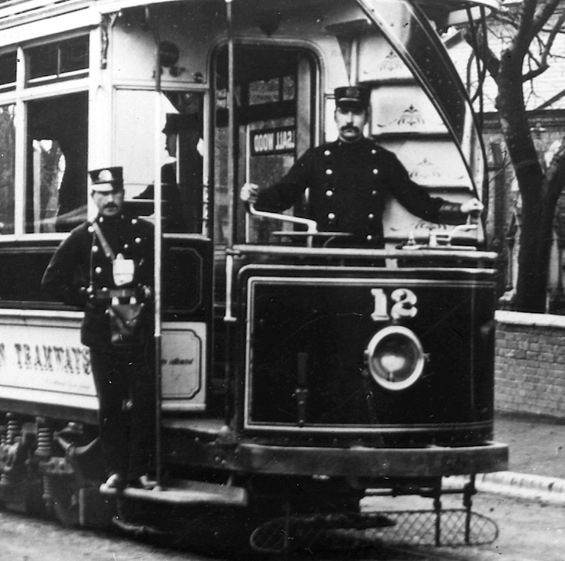
A conductor and a motorman pose with what is almost certainly a brand-new Tramcar No 12 on the Walsall Wood line — photo undated, but probably taken at or shortly after the inauguration of municipal services on the 1st January 1904. Photo courtesy of the Tramways and Light Railway Society, with thanks to David Voice.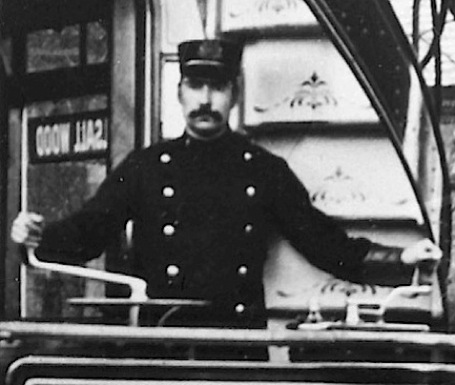
An enlargement of the above photograph, clearly showing the motorman's drooping-peak cap and the distinctively shaped cap badge (see below).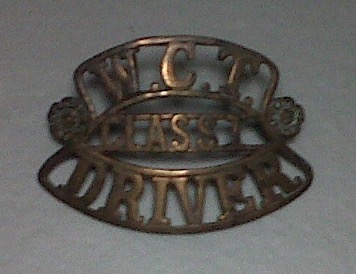
Edwardian-era Walsall Corporation Tramways cap badge — brass. With thanks to the National Tramway Museum.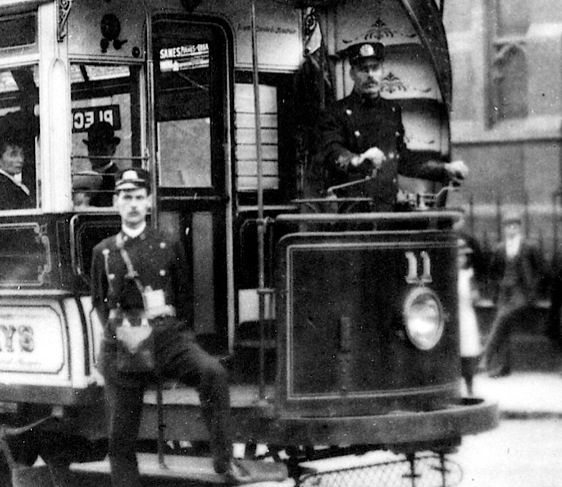
A conductor and a motorman pose for the cameraman with Tramcar No 11 at the Brown Lion in Pleck, on a through service over South Staffordshire Tramways Company-owned tracks to Darlaston — photo undated, but probably taken around 1907 when through services were inaugurated. Photo courtesy of the Tramways and Light Railway Society, with thanks to David Voice.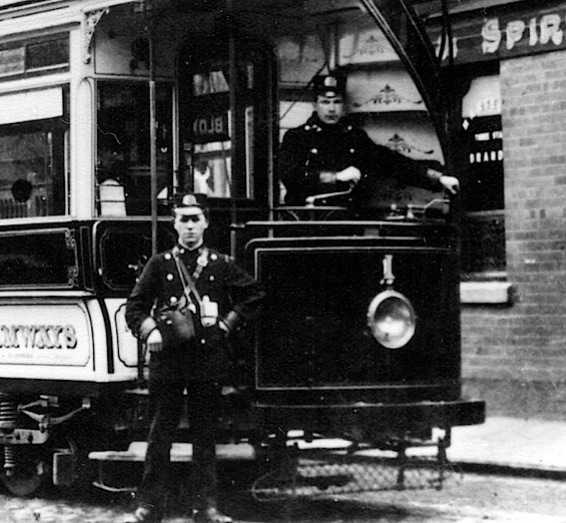
A conductor and a motorman with their charge, a recently outshopped Tramcar No 1, at the Kings Arms in High Street, with a service to Bloxwich — photo undated, but probably taken in 1905/6 as No 1 is top covered (not shown) and was originally delivered in open-topped form. Photo courtesy of the Tramways and Light Railway Society, with thanks to David Voice.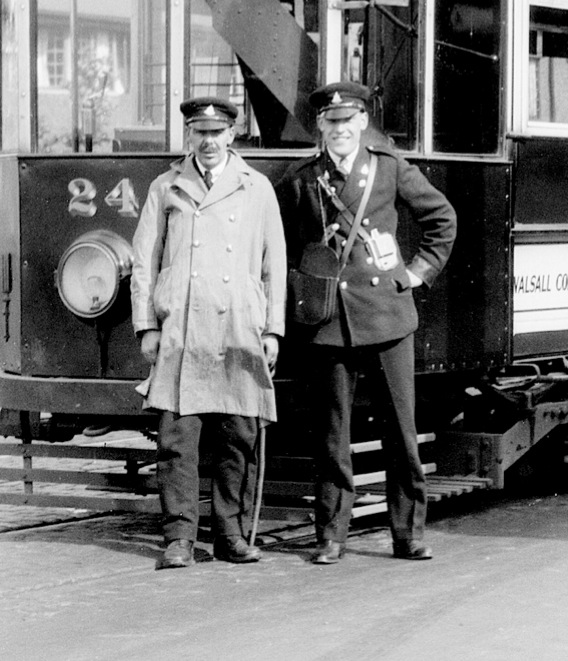
A motorman (in summer dustcoat) and a conductor, with Tramcar No 24 at Wednesbury in 1931. By this time the jackets had been changed to a much more modern double-breasted design with lapels. Both men are wearing soft-topped caps with a new style of cap badge. Photo by H Nicol, courtesy of the National Tramway Museum. 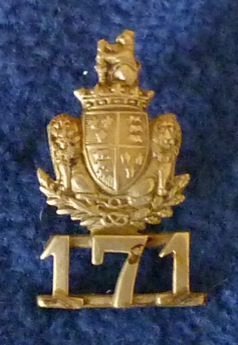
WCT collar badge — nickel — c1920s to 1930s. Author's Collection.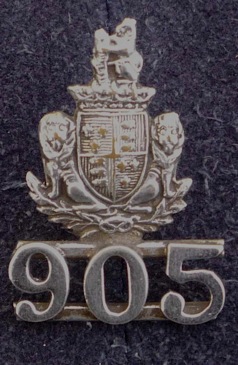
WCT collar badge — chrome — 1930s onwards. Author's Collection.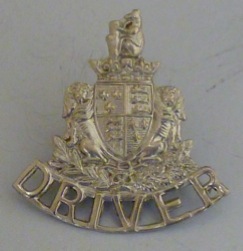
WCT driver's cap badge — chrome — 1930s onwards. Author's Collection.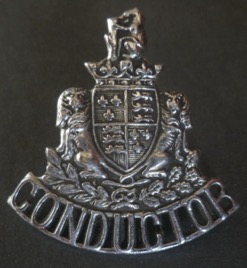
WCT conductor's cap badge — chrome — 1930s onwards. Author's Collection.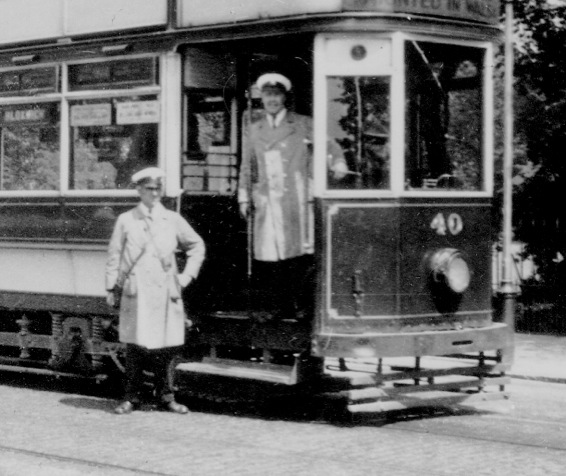
The crew of Tramcar No 40 in their summer coats at the Bloxwich terminus — photo undated, but probably taken in the 1932 or 33. Photo courtesy of the Tramways and Light Railway Society, with thanks to David Voice.